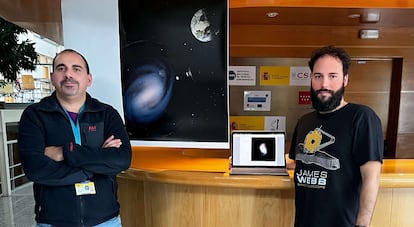Key Takeaways:
- Astronomers discovered a galaxy very similar to our Milky Way, but 11.7 billion years ago, when the universe was much younger.
- This galaxy, named ceers-2112, is the furthest Milky Way-like galaxy ever found.
- Surprisingly, ceers-2112 has a bar structure in its center, even though it’s very young, challenging our understanding of galaxy formation.
- The presence of a bar in ceers-2112 might be crucial for the formation of life-supporting planets.
- This discovery suggests there could be many more “twin” galaxies of the Milky Way at various stages of evolution throughout the universe’s history.
Astrophysicist Luca Costantin went on vacation to Cantabria, Spain. On his first day off, after exploring the beaches and green slopes of San Vicente de la Barquera, he turned on his laptop and began work. “I have a bad habit of looking at my email for an hour before going to sleep, even on vacation,” he explains.
His inbox contained new photographs captured by the innovative James Webb Space Telescope. “I started looking at galaxies and classifying them, when one caught my attention,” he remembers. He had recently discovered the galaxy ceers-2112, a sort of “twin sister” to the Milky Way, which is home to planet Earth, on the other side of space. The discovery was published in the prestigious science journal Nature.
The universe is approximately 13.8 billion years old. Costantin and his colleagues discovered that galaxies similar to the Milky Way existed 11.7 billion years ago, when the universe was only 15% the age it is now. The ultrasensitive James Webb Space Telescope has captured weak light sent when the universe was still in its early stages.
“It’s like seeing our galaxy back in time,” says Costantin, a 33-year-old Italian researcher. Astrophysicist Pablo G. Pérez González compared the discovery to a 100-year-old individual who has never seen himself in the mirror and receives a letter with a self-portrait from an unknown twin sister when he was 15. It is the furthest Milky Way-like galaxy known to science.
The galaxy Ceers-2112 is visible in an area of the sky between the constellations Ursa Major and Boyero, the dotted line that resembles a human figure and contains the star Arthur, one of the brightest in the sky. According to Pérez González, another of the study’s lead authors, the stars in ceers-2112 had a total mass equivalent to 3.9 billion solar masses, which corresponds to simulations of what the Milky Way looked like at the time. “At that time our galaxy had about 10 times less solar masses,” explains this researcher, who works alongside Costantin at the Astrobiology Center (INTA-CSIC), in the Madrid town of Torrejón de Ardoz.

The Milky Way, like other spiral galaxies in the nearby universe, has an elongated bar-shaped structure in the center. The Hubble Space Telescope, launched in 1990 and primitive in compared to the modern James Webb, enabled researchers to analyze approximately 2,000 identical galaxies 15 years ago. NASA astronomers found that central bars were the final stage in the evolution of spiral galaxies, forming when stars’ orbits became unstable and departed from their prior circular route. In these bars, massive amounts of gas accumulate and new stars emerge, shaping galaxies.
The young ceers-2112, which was just 2.1 billion years old when it produced the light that was detected by the telescope, had an unusual bar in its center. Pablo G. Pérez González discusses the significance of these elongated formations.
“They are tremendously important, for example, for life. For the Sun to form with its metals in the area where we are, and a planet to form around it with a lot of iron, a lot of nickel, as well as carbon, silicon, and all the ingredients of life, there had to have been previous stars with such elliptical orbits, transporting material from where more stars form in a galaxy to the outer zones,” according to the researcher.
Four years ago, another “twin” galaxy of the Milky Way, SPT0418-47, was discovered. This galaxy was a massive and stable object when the universe was just 1.4 billion years old. However, that galaxy did not have a bar. “The Milky Way can have an infinite number of twins, and we observe each one at a different age of the universe.
With the twins, we would like to understand the history of the evolution of the Milky Way,” says Pérez González. The galaxy ceers-2112 was named after the international project Cosmic Evolution Early Release Science, which included astrophysicists from the Center for Astrobiology.
Yetli Rosas Guevara, a Mexican astronomer, praised the latest study, in which she did not participate. “It is the first publication that finds in the childhood of the universe these spiral galaxies that have a disk with a central bar. At that early age we would expect everything to be more turbulent,” explains the researcher, who works with cosmological simulations at the Donostia International Physics Center, in San Sebastián, Spain. Rosas Guevara notes that the powerful James Webb Space Telescope has changed astronomy by detecting the universe’s initial galaxies.
With more observations, she says, it will be possible to find out if ceers-2112 was an exception in the infancy of the universe or if there were many twin sisters of the Milky Way in existence.

